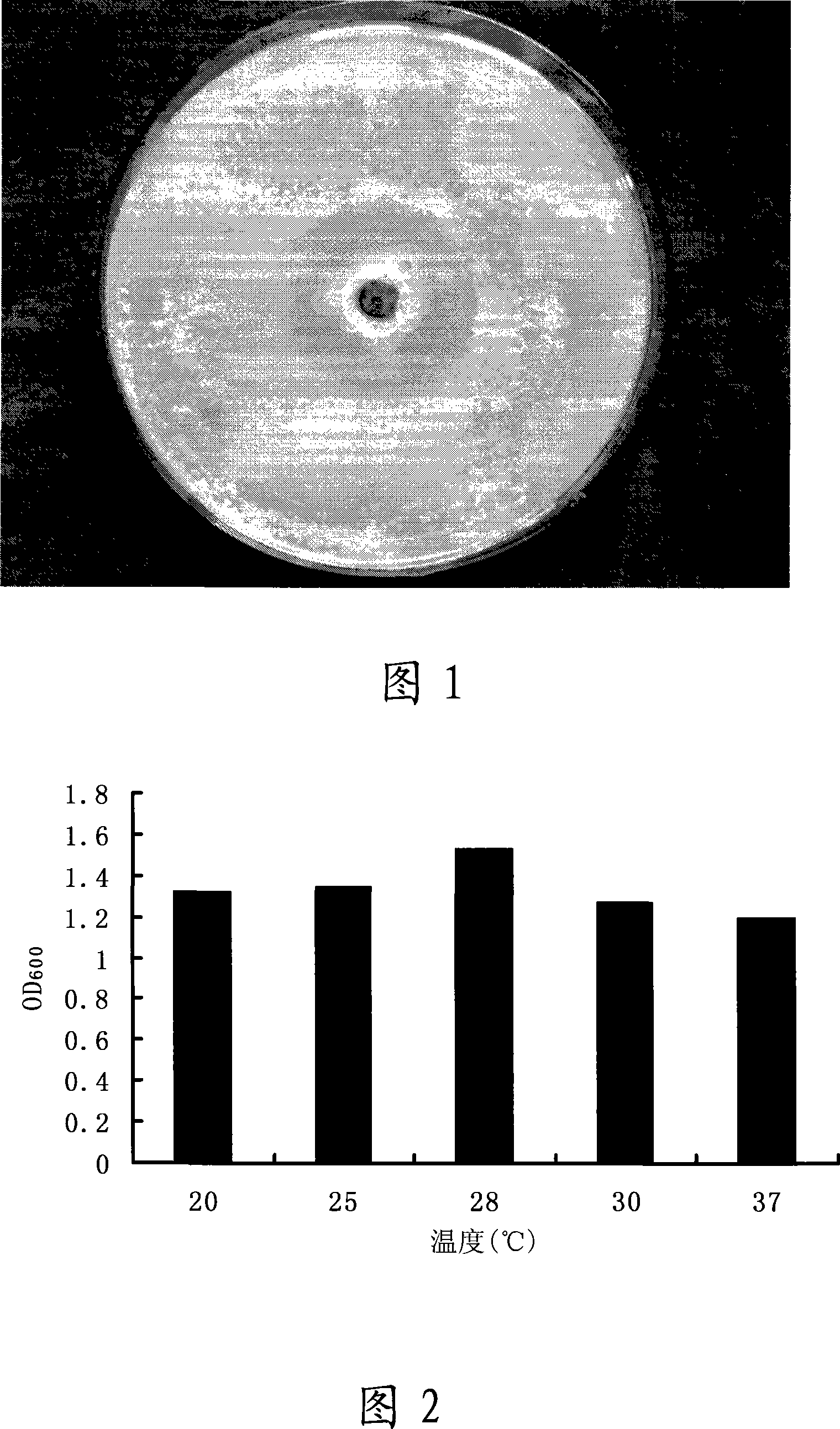Strain for preventing and curing muskmelon bacteroidal spot disease and application thereof in field disease prevention
A bacterial and spot disease technology, applied in the application, bacteria, fungicides and other directions, can solve the problems of destroying the ecological environment, increasing the burden on farmers, endangering human health, etc., to achieve no pollution to the environment, no harm to human health, and safe and reliable prevention and control. Effect
- Summary
- Abstract
- Description
- Claims
- Application Information
AI Technical Summary
Problems solved by technology
Method used
Image
Examples
Embodiment 1
[0026] Embodiment 1: the primary screening method of antagonistic bacteria
[0027] Draw 1mL of pathogenic bacteria diluted fermented liquid (hemocytometer and dilute to 1×10 7 1 / mL), 1 mL of different gradient soil dilutions were mixed in a sterilized empty test tube, and then 0.1 mL of the mixed solution was drawn and spread on a plate, and cultured upside down (28 °C, 48 h) to observe whether there was a zone of inhibition , record the size of the production circle, and pick a single colony in the production circle and use the plate streaking method to purify it, cultivate it at 28°C, and when a single colony grows on the medium, it is a pure strain, and inoculate the obtained single colony on the improved On the slant medium, cultured at 28°C for 48h, then stored in a refrigerator at 4°C for future use, see Figure 1.
[0028] A total of 195 strains producing inhibition zones were screened from 86 different soil samples by the test tube mixed bacteria plate coating method....
Embodiment 2
[0033] Embodiment 2: the double screening method of antagonistic bacteria
[0034] Select the strains with a bacteriostatic distance of more than 10 mm for re-screening by tube-and-disk method. Pathogenic bacteria suspension (1 × 10 7 each / mL) pipette 0.1mL and spread it on the plate, and use a sterilized hole puncher to punch holes on the plate, then add the antagonistic bacteria fermentation broth (fermentation culture at 28°C for 48h) into the punched holes, and then place in the incubator Medium culture (28°C, 48h) to observe the size of the inhibition zone, repeated three times.
[0035] The highly efficient and stable G-14 was screened from 63 isolates of antagonistic bacteria by the tube-and-disc method, and its antagonistic effect is shown in Figure 2.
Embodiment 3
[0036] Embodiment 3: the influence of temperature on the growth of Paenibacillus polymyxa (Paenibacillus polymyxa)
[0037] Inoculate G-14 into the liquid basal medium, the inoculum amount is the same as that of the growth curve test, culture in a shaker at 20°C, 25°C, 28°C, 30°C, and 37°C, with a rotation speed of 180r / min, until the stable stage, and use UV The -2550 spectrophotometer measures the OD value at a wavelength of 600nm, sets the non-inoculated culture solution as the control, and repeats it several times.
[0038] It is known from the above examples that the optimum growth and culture temperature of the bacterial strain of the present invention has antibacterial activity in the range of 20-37°C, and its optimum action temperature is 25-30°C.
PUM
 Login to View More
Login to View More Abstract
Description
Claims
Application Information
 Login to View More
Login to View More - R&D
- Intellectual Property
- Life Sciences
- Materials
- Tech Scout
- Unparalleled Data Quality
- Higher Quality Content
- 60% Fewer Hallucinations
Browse by: Latest US Patents, China's latest patents, Technical Efficacy Thesaurus, Application Domain, Technology Topic, Popular Technical Reports.
© 2025 PatSnap. All rights reserved.Legal|Privacy policy|Modern Slavery Act Transparency Statement|Sitemap|About US| Contact US: help@patsnap.com



